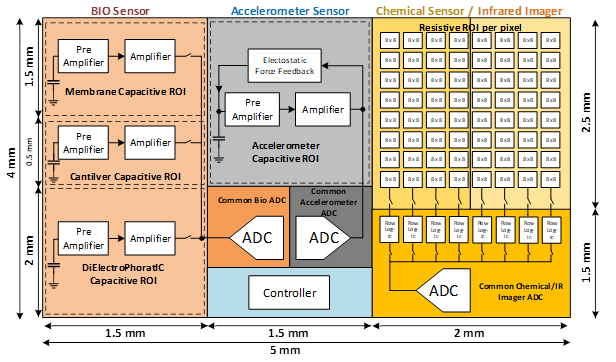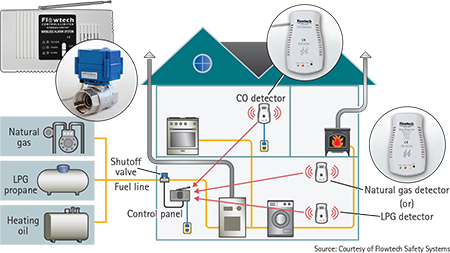Project Brief
Posted by edcasadmin on Saturday, 24 March 2018|
Project Description: This project focuses on structural-, chemical- and bio-hazard detection/prediction using a smart fusion of micro-sensor-systems, monolithically integrated inside a CMOS microchip, suitable as an autonomous sensing-node of a wireless-sensor-network (WSN). The proposed sensor-fusion includes MEMS accelerometers, IR absorption-based MEMS chemical sensors, Microcantilever based Bio-MEMS sensors and Microbolometer based low-cost IR imagers along with their configurable readout Microelectronics. Fig : 3D Illustration of the Multi-Sensor Chip Designed According to the Selected Methodologies
The main aim is to utilize the upcoming trend of FAB-supported monolithic Microsystems manufacturing, i.e. micro-sensors and micro-electronics inside the same CMOS die without or minimal post-processing of the manufactured silicon. This monolithic integration enables the realization of a low-cost, low-power, compact, robust and high performance system, which is batch-producible in millions. The proposed Microsystem design is not only limited to designing micro-sensors inside a CMOS process but the design of their electronic readout interfaces (ROI) is also an essential part. The applications of such a miniaturized multi-sensor system would include WSN scenarios; employed for the monitoring of structures, ambience and environment. The multi-sensor perspective helps to develop a context aware understanding of the scenario, which is a fundamentally useful aspect for the upcoming trends such as Internet-of-Things. For that reason, the correlation of the Microsystems’ specifications with the existing/emerging application paradigms necessitates for low-power profile, small foot-print, high transduction sensitivities and low production costs. A monolithically integrated system can better address these multifaceted specifications together by optimally exploiting the design-space instead of a discrete-component based sensor-system depending on generic off-the-shelf components.
Fig: A Generic View of the Multi-Sensor Chip Front-end and Back-end Components Design
From the sensor pool inside this microchip, tri-axial MEMS accelerometer is to be used for structural health monitoring (SHM) such as leakages in water/oil pipelines or analyzing vibration-signature of bridges. The proposed method of acceleration-gradient for vibration-analyses is non-invasive and retro-fitable, equally suitable for new, old, short and extremely long outdoor structures.
Fig: A system-level Representation of Structural Health Monitoring (SHM)
Likewise, a configurable MEMS chemical sensor is to be used for gas leakage detection at domestic sites or green-house gases concentration in a locality or warfare gases in case of a chemical attack. The proposed IR absorption spectroscopy based chemical sensor has a high reusability, suitable for long autonomous operational periods.
Fig: Representation of Gas-Leakage Detection System
Furthermore, a Bio-MEMS sensor is to be used to detect harmful pathogens with short assay times as compared to the conventional in-vitro methods. This will enable timely antigen identification with minimum false-negatives/positives for time-critical diagnosis. Such Biosensors can also be used to trigger quick reaction in case of bio-terrorism. The Bio-MEMS would have the capability to detect both water-borne and air-borne pathogens with a high reusability.
Fig: A Bio-MEMS based System for Pathogen Detection in Drinking Water
Additionally, an un-cooled Microbolometer IR imaging array is to be used for hot-spot analyses (HSA) to predict structural anomalies before they cause major damage. The IR imaging may also be used to analyze the alarms raised by primary sensors to minimize false negatives/positives alongside intruder detection capability.
(a) (b) (c) Fig: Applications of IR Imaging (a) Moisture content detection for leaks in walls (b) Thermal Imaging for Security Purpose in Houses (c) Pipeline Anomaly Detection
The expected outcome of this project is a manufactured CMOS die containing monolithically-integrated micro-sensors and their readout electronics. The novelty of this Microsystem would be based on the monolithic integration and functional enhancements of multiple micro-Systems’ existing designs. Such an integrated Microsystem can pave the way for low-cost, robust, multi-sensor, context-aware and wide-spread monitoring of major lifeline systems and resources of our society, positively affecting and connecting both security and standard of life with high-end academic research.
Expected Outcomes
|

.png)



.jpg)


